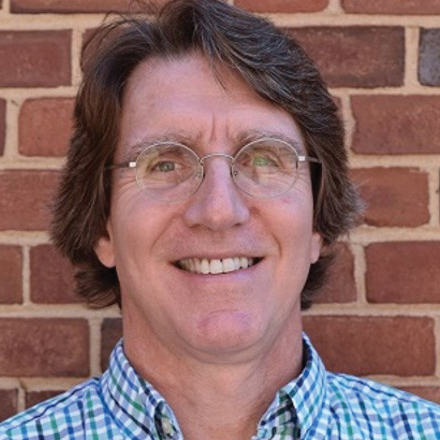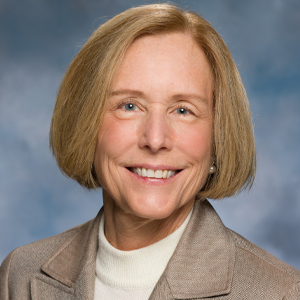Talking about membership
To increase awareness of American Society for Biochemistry and Molecular Biology activities, during my term I’ll be talking to chairs of the committees that steer the society’s initiatives.
First up is Ed Eisenstein of the Membership Committee, which focuses on the retention, growth and engagement the ASBMB membership. The committee is charged with considering, reviewing and recommending actions to implement programs, benefits and services to advance the mission of the society and meet the needs of its members. Ed is an associate professor of bioengineering at the University of Maryland, and he has chaired the committee since 2019.

This conversation has been edited.
Ed, when and why did you become an ASBMB member?
I joined the ASBMB when I was a postdoctoral fellow with Howard Schachman at the University of California, Berkeley. It was in the late 1980s; Howard was the ASBMB president, and it was an interesting time — the society changed its name from the American Society of Biological Chemists to the American Society for Biochemistry and Molecular Biology, and you didn’t have to be nominated or to have published a first-author paper to become a member; it was merely a matter of filling out an application.
The main reason I joined, aside from Howard twisting my arm a little bit, was that I had some scientific and career aspirations, and I was encouraged by what the society had available. We still do a lot to help scientists reach their goals. It’s been a great relationship. They’ve trusted me as a meetings organizer, as an editor for the Journal of Biological Chemistry, as a member of a couple of committees and now chair of the Membership Committee. We’ve had a great ride, and I appreciate what they’ve done for me and my career.
You have a research program that focuses on engineering plants. Tell me about that.
My training is in structural enzymology. I had a long career as a university administrator where I ran a biotechnology center and even served a term as university president.
Rather than continuing that path, I decided about 10 years ago I wanted to turn back. I shifted my focus from looking at the molecular interactions among proteins to thinking about engineering plants. I really wanted to address the energy crisis.
We work on poplar trees as a model to develop healthy bioenergy and biofeedstock sources. Our work involves molecular, cellular and genome engineering. We’re trying to redesign aspects of their immune system to make them more resistant to pathogens and pests, modulating effects of abiotic challenges like excess ultraviolet light or drought, and also to improve nutrient acquisition — nitrogen, in particular. It’s something I’ve wanted to do since I was an undergraduate.
Given this broad and multidisciplinary research, what attracts you to the ASBMB?
I affiliated with a bioengineering department because I wanted to build a plant. I was trained in biochemistry and molecular biology with an aim toward trying to uncover mechanism. If we really want to redesign or reengineer systems, a better understanding of mechanisms is critical. This society is a great organization where I can continue to learn a lot about molecular mechanisms and biology.
The other thing that keeps me engaged in this society is the terrific benefits. I’ve urged my engineering students to join the ASBMB, even though it’s not their first discipline, because of these assets. I’ve had a number of students take the Art of Science Communication course to get more comfortable talking about their science, which has helped them get through their preliminary exams and defend their dissertations.
What motivated you to join the Membership Committee?
I was very active on the Public Outreach Committee for about six years back when it formed. I was running a science cafe during a blood drive on campus, and Geoff Hunt (former ASBMB outreach manager) came up to me and said, “Gee, this is really great. I’m starting this Public Outreach Committee at ASBMB. Would you like to participate?”
The Membership Committee had been in place some years previously and had lapsed. With Pete Kennelly as chair, they were trying to reformulate it about four years ago. They wanted to recruit members of various committees to constitute the Membership Committee, so Barbara Gordon (former ASBMB executive director) asked me if I’d serve. It was hard saying no to Barbara — she’s very persuasive. So I said, “Sure, I’d love to join.”
The Membership Committee was doing new activities: marketing, surveys and focus groups. Because I was at Maryland, so close to the ASBMB office, I was involved in a lot of those, and I spoke up and spoke my mind. I guess I spoke up enough that they thought I could walk and chew gum, enough to ask me if I wanted to be chair after Pete’s term.
The Membership Committee is a great group of folks. Like a lot of ASBMB committees, it’s vibrant and interactive. We do a lot of good work, and we have a lot of fun in the process.
What was the committee’s most important new initiative during your past term as chair?
By far, it’s the development of the fellows program. The ASBMB is one of the oldest scientific societies in the country, and we were one of the last to recognize fellows.
Our committee thought our fellows would be a visible sign of the society’s values: terrific science, terrific outreach, terrific education, and commitment to life science ideals and education and outreach. In starting the program, we hoped we could provide the fellows with information and opportunities to continue to be good ambassadors.
What attributes weigh most heavily in the committee’s selection of fellows?
Our rubric calls for recognizing members who demonstrate an exceptional and sustained commitment to the society, particularly in ways that advance molecular life sciences.
The fellows need to reflect the breadth and diversity of our membership, whether they are researchers, educators, mentors or advocates for the field. It’s not just about the best science. It’s about all the aspects our society takes under its wing. A subcommittee led by Judy Bond, a past president of the ASBMB, brings nominations to the full committee for a vote, and then we bring those to the ASBMB Council for final approval.
Tell me some things you learned from the ASBMB’s 2020 member survey?
Members, especially early-career members, had a strong desire to network, especially with other members they share common interests with — whether it was developing educational programs or developing a scientific thrust in a new area or a multidisciplinary area.
Also, retention in the ASBMB correlates with how active members are in the society. That was an important eye opener for everybody on the committee. It really helped guide the elements of our Strategic Plan, to find ways to keep all of our membership engaged and active in ways that they feel will make the society vibrant.
Are there new initiatives in this Strategic Plan?
We’re trying to put materials together and cultivate opportunities for fellows and other senior members in the society, Council members and so forth, to be more effective ambassadors for the society. We get a lot of questions from young people about how to get involved, and we want to have that information at peoples’ fingertips.
We made it a goal for next year to develop road maps for career stages in the many paths of our members — not just people in academia but also industry, government science or policy institutes. We want them to know that at every step in their careers, this society has something to help them reach their goals.
There’s a lot of interest among members in specialized topics and, for lack of a better term, special interest groups. We’re looking for ways to organize them, whether they’re around education or research topics or outreach activities, so like-minded members will have venues where they can kick the can and discuss ideas and maybe generate new programs.
How do the 18 Membership Committee members contribute to the committee’s goals?
They contribute their time, their attention and their talent to look at the benefits the society offers and figure out how well those benefits align with members’ current needs. We have a diverse committee. We have biochemists and molecular biologists at all career stages. We have people from industry, nonprofits and academia. We have a good cross section of ASBMB membership so we can keep an eye out for how we can keep benefits vibrant for members.
And committee members participate in the programs we run at the annual meeting. We have a new-member orientation, we recognize and engage with our ambassadors and fellows, and we interact with students and postdocs at the various symposia to make sure the society’s got their back as they advance for their career. So our members keep busy at the annual meeting, not just by attending scientific sessions but also by working at the collateral sessions we offer.
How can ASBMB members interact with the committee and help to further its goals?
Our members are not shy. When they want to get ahold of somebody, they know how to reach out, and they do. They can write to anyone on the committee or me as committee chair. All our names are listed on the website.
The ASBMB recently hired a new membership manager, Nakera Dumas. She’s got a great background in society memberships. She’s a data-driven scientist herself. She's got great experience to help us identify programs that will add value to members and things they’ll be interested in. Society members can reach out to Nakera with any questions, any interest in contributing or collaborating with us, even temporarily, if they have an idea for a symposium or workshop.
Also, the committee is always looking for new members. In fact, a call went out in August for ASBMB members to volunteer to serve on committees within the society. We’ll have another general call next year. And meanwhile, people can contact Nakera or write to me with their interest, and we’d be happy to accommodate them as full- or part-time members.
This is the season for membership renewal, so what do you consider to be the value proposition for membership in the ASBMB?
That’s the bread and butter of what the Membership Committee does.
The ASBMB offers an awesome set of benefits for members at all career stages, no matter what their path is in molecular life science. We have programs for undergraduate students, graduate and postdoctoral trainees, young investigators, midcareer and senior scientists. Our training programs offer accredited certificates. We have seminars on managing your lab and your research team, writing successful grant proposals, transitioning from scientist to administrator — something I could have used a decade ago — and how to engage with our public stakeholders.
Plus, we have three highly rated and impactful journals, and we run terrific scientific meetings. The ASBMB’s got everything scientists can use throughout their entire career trajectory, and there’s no reason not to be a life-long member.
Enjoy reading ASBMB Today?
Become a member to receive the print edition four times a year and the digital edition monthly.
Learn moreGet the latest from ASBMB Today
Enter your email address, and we’ll send you a weekly email with recent articles, interviews and more.
Latest in Opinions
Opinions highlights or most popular articles

How pediatric cataracts shaped my scientific journey
Undergraduate student Grace Jones shares how she transformed her childhood cataract diagnosis into a scientific purpose. She explores how biochemistry can bring a clearer vision to others, and how personal history can shape discovery.

Debugging my code and teaching with ChatGPT
AI tools like ChatGPT have changed the way an assistant professor teaches and does research. But, he asserts that real growth still comes from struggle, and educators must help students use AI wisely — as scaffolds, not shortcuts.

AI in the lab: The power of smarter questions
An assistant professor discusses AI's evolution from a buzzword to a trusted research partner. It helps streamline reviews, troubleshoot code, save time and spark ideas, but its success relies on combining AI with expertise and critical thinking.

How AlphaFold transformed my classroom into a research lab
A high school science teacher reflects on how AI-integrated technologies help her students ponder realistic research questions with hands-on learning.

Writing with AI turns chaos into clarity
Associate professor shares how generative AI, used as a creative whiteboard, helps scientists refine ideas, structure complexity and sharpen clarity — transforming the messy process of discovery into compelling science writing.

Teaching AI to listen
A computational medicine graduate student reflects on building natural language processing tools that extract meaning from messy clinical notes — transforming how we identify genetic risk while redefining what it means to listen in science.

